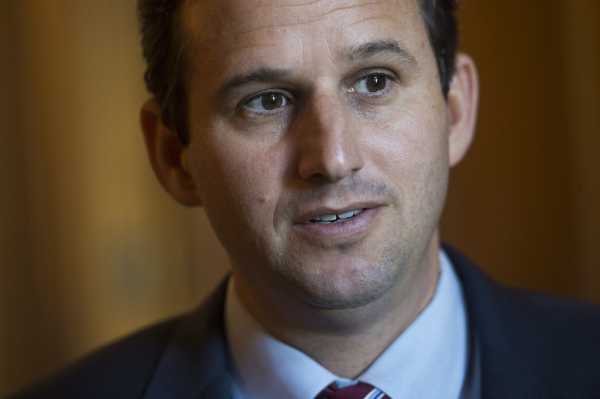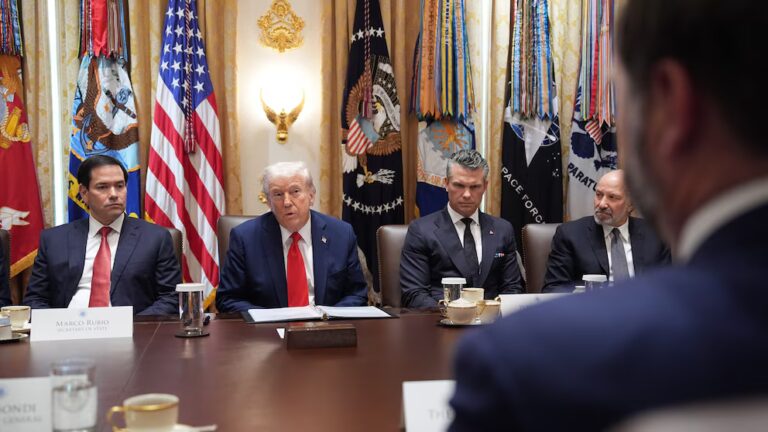
On Thursday, Sen. Brian Schatz (D-HI) will introduce perhaps the boldest plan yet to make college more affordable: a federal-state partnership with a $95 billion price tag that would result in debt-free college for public university students.
It’s an attempt to reverse the current trend of states disinvesting in their public colleges. Under the system set up by Schatz’s Debt Free College Act of 2018, participating states would get a dollar-for-dollar match from the federal government for however much funding they appropriate for public two- and four-year schools. In exchange, those schools would have to commit to helping students pay for the full cost of college without taking on debt, using need-based grants.
Schatz estimates 10 states would immediately reach debt-free college for their state schools, while the other 40 states would get to debt-free college for many of their Pell Grant recipients. More students would be added as more states sign on. (You can read more about what the bill contains in my explainer.)
“Part of what we want to do is not just cover the whole amount that the states have backed out [of] but reverse the trend of disinvestment at the state level,” Schatz told me. “Because this is really, at least partly, a state responsibility. And I promise you, as a former member of a state legislature, the best way to get the state to put money on the table is to provide a match.”
Schatz’s proposal shows that the progressive shift on college affordability seen in 2016 has not gone away. The Democratic thought had long been that students should be responsible for paying for part of their college education, even if that required student loans. That was, until the 2016 presidential election, when a groundswell of college students supporting Sen. Bernie Sanders’s vision for tuition-free college pushed the idea into the mainstream.
But with nationwide student debt now a $1.4 trillion problem, second only to US mortgage debt, the calls to do something to make college affordable are growing, especially from students.
“No family escapes this,” Schatz said. “It’s important to remember this is a problem primarily about young people, but it impacts parents and grandparents. It impacts a lot of parents who are still paying off their own loans while saving up for their kids. When you’re talking about that much debt, nobody escapes it.”
Democrats are not in power in Congress or the White House right now, but with the 2018 midterms looking like a possible wave year, lawmakers like Schatz are trying to ready progressive visions for issues that still need to be tackled. Though Schatz’s legislation comes with a hefty price tag, he thinks it’s worth the cost.
“I don’t play the pay-for game. I reject the pay-for game,” the senator said. “After the Republicans did the $1.5 trillion in unpaid-for tax cuts, and as we’re doing a bipartisan appropriations bill — which I support — which is also an increase in federal spending [that’s] unpaid for, I just reject the idea that only progressive ideas have to be paid for. We can work on that as we go through the process, but I think it’s a trap.”
I sat down with Schatz recently to talk about how his plan is different from past proposals, the lack of action on this issue, and whether he thinks Republicans will get on board. Our interview has been lightly edited for length and clarity.
Ella Nilsen
I wanted to ask you why you’re bringing this up now, given the current political landscape of Congress.
Brian Schatz
We have a problem of national economic policy. For the first time, it is an open question whether or not it makes sense, for at least certain young people, to go to college and to incur that amount of debt. It has literally never been the case, prior to the last maybe 10 or 15 years, that it wasn’t an open-and-shut case — yes, you should go to college.
Think about what a malformed system we have if we cause our young people to accumulate so much debt that they can basically never crawl out. It’s non-dischargeable. It’s $1.4 trillion. It exceeds credit card debt; it’s second only to mortgage debt.
Also, as a result of the last primary election, we have not really dug in very seriously to what policy makes the most sense going forward. We’ve now, as a party, decided that we want kids to be able to afford college. And what I’m trying to do here is flesh out how we do that.
The reason we’re excited about this proposal is that the total cost of college, all in, on average, is about $20,000 [yearly]. The average tuition is about $8,900. So covering tuition is not going to get it done for a lot of young people.
Ella Nilsen
I’m curious how you see this plan being different from some of the other plans that have already introduced. I was reading Hillary Clinton’s college affordability plan on the way over; obviously, Sen. [Elizabeth] Warren, Sen. Sanders have introduced them in the past.
Brian Schatz
So the first thing I want to say is that everybody is sort of paddling in the same canoe, in the same direction. Number two is, I like all of the ideas that have been proffered. Covering tuition for everybody is not a bad idea — it’s just that tuition is only 45 percent of the cost of college. And I also believe that we ought to cover the full cost of college for people who can’t afford it before we cover tuition for people who can.
I think the question of the student loan interest rates set by US [Department of Education] is an important question; I’ve been on Elizabeth’s bill regarding that. But that’s also only a portion of the problem because frankly, when you’re in $200,000 of debt, it’s not the interest, it’s the principal. Whether you’re paying 6 percent or 4 percent, you’re functionally bankrupt, and that’s the problem we have to get at.
And then Hillary’s plan, frankly, we just went over it yesterday. It’s tuition-free, but it’s sort of more of a sliding scale. But they [Sanders and Clinton] were both working on tuition-free. And I think debt-free is where we need to be. Because for a lot … by the way, this $8,900 out of $20,000 … these are averages; as you know, averages can be misleading. Some schools, the tuition may be relatively small. City colleges, right? But then you’re trying to live in the city of New York; your problem is not tuition, it’s living in the city of New York. And so we really want to address the total cost of college.
Ella Nilsen
From your position as a former state legislator, what do you think states are looking for from the federal government when it comes to education affordability plans like this?
Brian Schatz
They want resources. But they also want an incentive to reverse the trend of disinvestment. Some states have not disinvested, and one of the benefits of our plan is it’s a match program. In other words, they get rewarded for current investment. In other states, I think as budgets improve, as the National Governors Association meets, as the national legislatures meet, they will find that their colleagues in other states are doing better in pulling down federal resources because of the investment. And that’s what they want.
I’ve been looking at education policy for five-plus years, and the for-profit universe, I think, is its own national scandal. The student loan interest rate is an important issue. The problem of the Department of Education accrediting institutions that I think don’t deserve accreditation, the specific predation and targeting of veterans to maximize revenue when the outcomes are so awful on the for-profit side. All of those are important issues, but in terms of financing and making college affordable, we tried to take as comprehensive an approach as possible.
Ella Nilsen
Would you characterize your plan as more ambitious than Hillary Clinton’s plan or some of the other plans that have been put forward?
Brian Schatz
Yes. I mean, I’m always cautious to turn this into “is my plan better than Hillary’s” and “is my plan better than Bernie’s,” but I guess what I would say is, it’s my plan; of course I like it better.
But we do have a number of members who are going to be co-sponsoring: [Sens.] Kirsten [Gillibrand], Cory [Booker], Kamala [Harris], Jeff [Merkley], Elizabeth [Warren], Sherrod [Brown], [Richard] Blumenthal, and [Tammy] Baldwin. And that group will grow over time, including House members. But part of what I’m trying to do is prepare for the very real possibility that we will have gavels soon.
One of the things I have observed among Republicans — and part of it is that they’re just unserious about governing in the first place, but I certainly observed on health care that they had no actual legislative program once they got the gavels. And I think it’s important for us to draw a clear contrast with Republicans over the rest of the year, but also be ready to govern. This is a program that could be implemented right away.
Ella Nilsen
Obviously, Republicans and Democrats have different ideas on how to fix education, but you were talking about the Fed chair, Jerome Powell — he’s Republican. Fundamentally, this seems like at least there’s bipartisan agreement that student debt is a huge problem. And I’m just curious what your thoughts are on why there haven’t been any moves to fix this.
Brian Schatz
You mean on the Republican side?
Ella Nilsen
Yeah.
Brian Schatz
I can’t defend it, because you’ve got to believe that making college affordable should be a bipartisan enterprise. But my own judgment is that when students rise up and demand this, politicians of all stripes will listen.
And I will say that although Republicans tend not to prioritize this, I don’t think they will object if we are able to find resources to do it, because they would be able to go back to their home state and their governors and their flagship institutions and say, “We’re going to make college more affordable.” Which is a popular thing to do!
Ella Nilsen
So where does the money come from for the federal match?
Brian Schatz
So, I don’t play the pay-for game. I reject the pay-for game. After the Republicans did the $1.5 trillion in unpaid-for tax cuts, and as we’re doing a bipartisan appropriations bill — which I support — which is also an increase in federal spending [that’s] unpaid for … I just reject the idea that only progressive ideas have to be paid for. We can work on that as we go through the process, but I think it’s a trap.
Ella Nilsen
But have you identified any sort of taxes or anything like that?
Brian Schatz
No. I mean, in my head, I know what we could do. One of the games that the Democrats do in response to, “How are you going to pay for it?” is you say, “Well, carried interest.”
I could give you 14 things that would generate $1 trillion, but I just don’t think we should be playing the pay-for game right now. This is a national priority, and to the degree and extent that we really believe in this, we have to push for it. And I certainly think it’s more important than the tax relief that was provided for the wealthiest and most profitable corporations in the history of the planet.
Ella Nilsen
Something else I wanted to ask. I covered the New Hampshire primary in 2016 — I had the interesting position of covering both Bernie Sanders and Donald Trump.
Brian Schatz
I saw that in your bio, I was like, wow. When are you writing a book?
Ella Nilsen
[laughs] Hopefully not … I don’t have the patience to relive that experience. But the point that I’m trying to make is that I remember this issue would come up all the time at town halls for both of them. And Trump would get asked questions about it, Sanders would get asked all the time about it. And then after 2016, you heard nothing.
Brian Schatz
It just vanished.
Ella Nilsen
Yeah, what are your thoughts on that?
Brian Schatz
One of the reasons I feel so strongly about this is that I think both parties have been running on this, and we haven’t done the hard legislative work. And on a personal level, I prioritized this in my 2014 campaign, and I told my staff, “I don’t want to be coming back in 2022 running on college affordability again.” Because then it’s just a device for getting votes.
And I think one of the reasons we have failed is that people agree with us, but they don’t believe we’re deeply committed to solving the problem. And as I met with kids, especially at the University of Hawaii in Manoa, I was able to go into some depth about the problem, as opposed to saying, “My plan is better than so-and-so’s plan.” Or, “Those guys are not letting us do what really needs to be done.”
But rather, look them in the eye and say, “This is expensive and complex, and it’s one of the top two or three things that we have to do as a country. It’s going to take a while, and it’s going to take a level of seriousness, and I can’t describe my college affordability program in three sentences. I’m sorry. But what I owe you is seriousness about this policy, as opposed to something that will just trigger your political support.”
You get a six-year term, and you get the luxury — and the obligation — to actually try to fix something. And that’s what this is about; this is why I’ve devoted so much staff time and so much personal time to getting serious about this problem. I don’t want to go back to every college campus eight years after my first election and say the same stuff. Whether it works or not in the electoral context I think is a separate question. Whether I can stomach, morally, just talking about college affordability for eight years, or 14 years, or 20 years … shame on all of us for running on this without fixing it.
Ella Nilsen
Obviously, Democrats are not in the majority right now, but past 2018 and looking into the future, I know that health care is a huge focus; there are many other things that are a huge focus. Where do you see affordable education fitting into all of that?
Brian Schatz
I think it’s in the top two or three. Obviously, you’ve got Medicare-for-all, you’ve got my Medicaid public option bill. I think we will have to do something on climate, and that will depend a lot on the configuration of the Congress. That, in my view, is not as complex of a policy issue, where the work hasn’t been done. That’s just a matter of whether we have the votes or don’t have the votes. But I think it’s in the top three to five issues. And what I like about this is it’s basically a funding question. We have to set up the mechanisms right, but if we prioritize it, we can do it.
Ella Nilsen
Is this something you see potentially getting done as soon as 2018, or do you think it’s going to have to happen after 2020?
Brian Schatz
It depends on the outcome of the election. It really does. And I mean, everything depends on the outcome of the election.
Ella Nilsen
It sounds like this is voluntary, so this is something that states could opt out of if they wanted to?
Brian Schatz
One thing I’ll point out about that: There are a lot of programs … Medicaid is voluntary. Once there’s money on the table, over time, states participate. Red, blue, purple — everyone has great difficulty turning down federal money for an important priority. So while you might have lower rates of participation among Republican states, over time that smooths itself out, and over time everyone realizes that when there’s federal money on the table, you take it.
Ella Nilsen
This question might be a little too in the weeds, but I was wondering if you’ve thought about how allocations would work — whether it would be larger states getting money.
Brian Schatz
I mean, correct me if I’m wrong, but it’s basically a dollar-for-dollar match. So yeah, big states would get more, but they have more need. It’s literally whatever the state general fund appropriation is for the public institutions, they get the same amount.
There are ways to game this, so we’re working with the State Higher Education Executive Officers Association to try to make sure it doesn’t get manipulated. Say, tuition money could land in the general fund, visit the general fund for 45 seconds, and then get appropriated to trigger the match. So we’re just trying to make sure that none of that gets gamed. You do the same thing with CMS and Medicare and Medicaid. You write the rules so that nobody gets to just trigger federal funds without new resources.
Ella Nilsen
How are things in your home state of Hawaii with college affordability?
Brian Schatz
We’re actually a good example of a place where tuition is not the problem but the cost of going to school is crazy. We have one of the most expensive housing markets in the country. So tuition for out of state is a little higher, in state it’s very affordable; it’s a great institution. But the problem is trying to subsist and survive while you’re a college student.
A lot of [students], as a result, have to be working part time. And the problem then is you work part time and it’s hard to finish on time. One of the things with some of these universities is the average time to graduate for full-time students is not four years.
Sourse: vox.com






